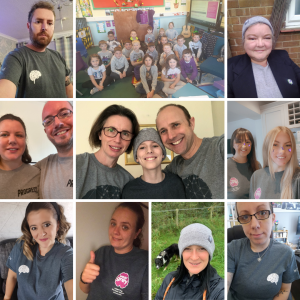On 1st October, you chose grey and you changed lives.
Once again, we were overwhelmed by the show of support we received during the first week of October as we honoured the 60,000 people living with a brain tumour here in the UK. People from far and wide came together, and by wearing grey, our community raised an enormous amount of awareness and over £5,000 (and counting)!
Following the launch of our brand new Wear Grey merchandise, we were thrilled to see how fabulous everyone looked rocking their brainstrust tees, beanies, face masks and neck warmers! With big smiles all round, we could tell just how much this day meant to you and we’re truly honoured to be part of such a passionate community. Whether your shared your personal story, honoured a loved one, snapped a selfie or celebrated with family, friends and colleagues – you really did change lives.

We would like to thank each and every person who supported Wear Grey 2020. Your kindness and generosity truly does mean the world to us, even more so during these very difficult and uncertain times.
30 people are still being diagnosed with a brain tumour every day. In a world that has been more isolating than ever, the varying restrictions across the UK mean that people have been alone when they find out they have this devastating illness. People have been unable to visit loved ones in hospital. Necessary shielding has prevented precious time from being spent with family and friends. People with a brain tumour have suffered two-fold. Thanks to you, brainstrust is here to provide specialised, dedicated support 24/7, 365 days a year.
The funds raised throughout our Wear Grey campaign ensure that we can continue to work round-the-clock to keep our support going. We’re there for people when things are scariest, and we’ll be here every step of the way on their journey. Making sure they can have their best possible day, whatever that looks like for them. Through our coaching, workshops and resources, we are tackling isolation and building communities for people with a brain tumour.
Thank you once again for your continued support. We hope you’ll be back to join us next October as we celebrate Wear Grey 2021. In the meantime, there’s lots you can get involved with! Don’t forget to check out our brainstrust Events Calendar where you can find out what’s going on in the coming months. For any further fundraising enquiries, please email sophie@brainstrust.org.uk





